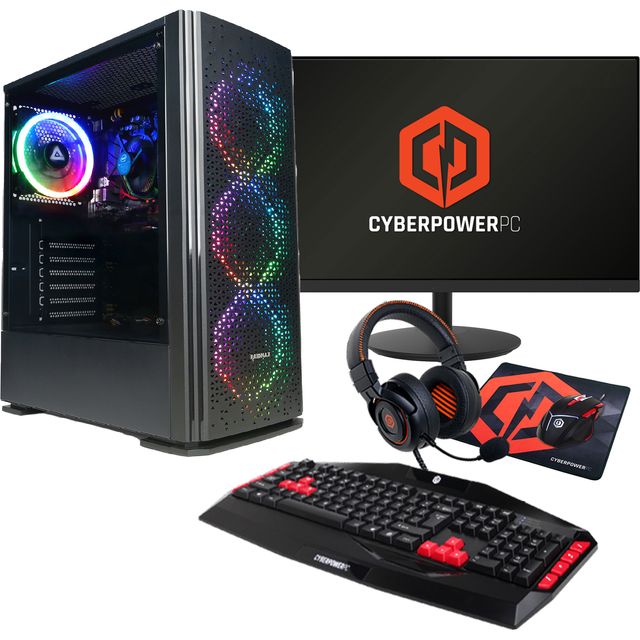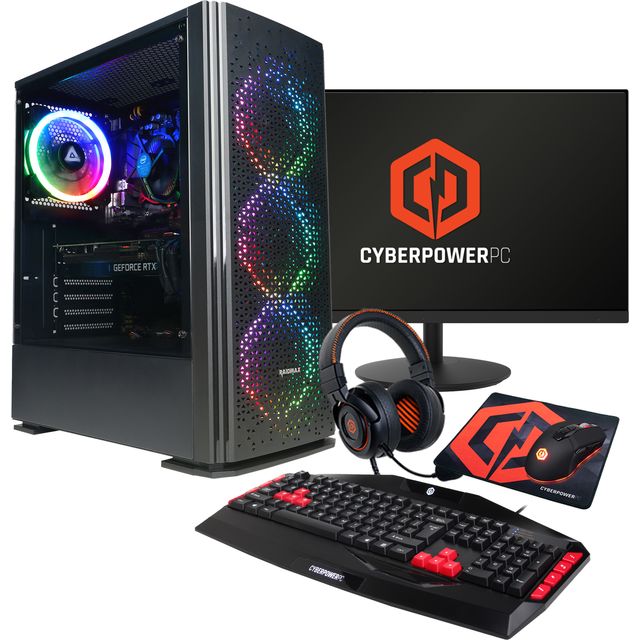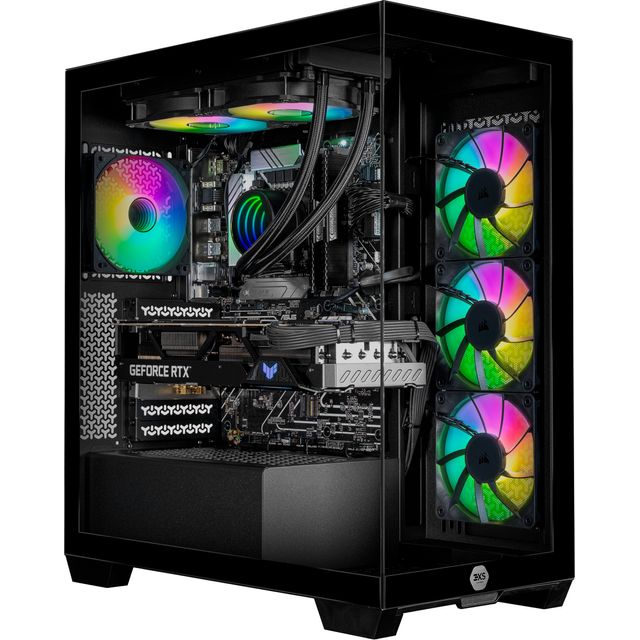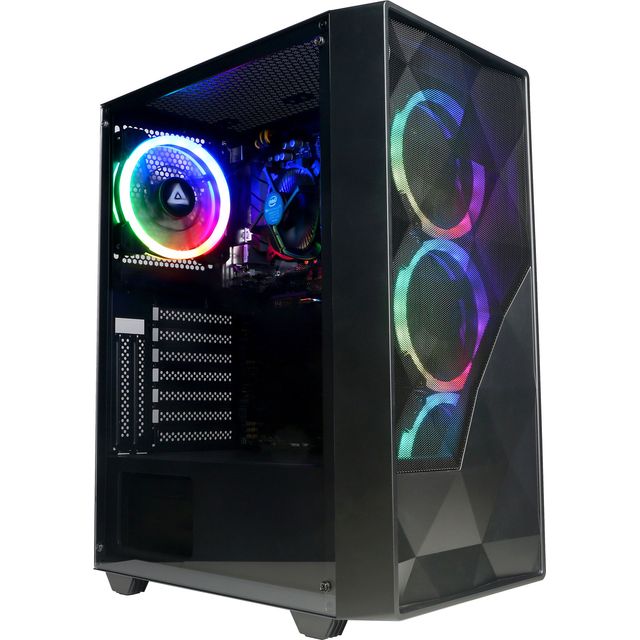Our site uses cookies to give you the best experience. or continue shopping if you're happy.
Accept & closeDesktop computers
Things to Know
There are some essential product details you'll want to consider before starting the search for your new computer. Our handy videos will help you narrow down the options to make sure you find exactly what you need.
Shop all

CyberPowerPC AO22225 Gaming PC - AMD Ryzen™ 5, 500GB SSD - Black

CyberPowerPC AO22221 Gaming PC - NVIDIA® GeForce RTX™ 4060, AMD Ryzen™ 5, 1TB SSD - Black

HP 24-cr0063na All In One - Intel® Core™ i3, 256GB SSD 2025 - Shell White

3XS Halo 5080 Gaming PC - NVIDIA® GeForce RTX™ 5080, AMD Ryzen™ 7, 2TB SSD - Black

CyberPowerPC AO010901 Gaming PC - AMD Ryzen™ 5, 480GB SSD - Black

ASUS V400 AiO 23.8" All In One - 512GB SSD - Black

HP OmniDesk M02-0005na Tower - AMD Ryzen™ 5, 1TB SSD - Gray Wood

Acer Nitro 20 N20 Gaming PC - NVIDIA® GeForce RTX™ 3050, Intel® Core™ i5, 512GB SSD - Red / Black

CyberPowerPC AO22234 Gaming PC - NVIDIA® GeForce RTX™ 5060, AMD Ryzen™ 5, 1TB SSD - Black

CyberPowerPC AO22231 Gaming PC - NVIDIA® GeForce RTX™ 5050, Intel® Core™ i5, 1TB SSD - Black
Did you know?

Dust = heat = lag.
Get in the habit of opening up that case every 2–3 months, and give it a gentle vacuum. Better yet, use compressed air if you've got it. Your system will thank you.

Dual monitors = productivity boost.
Before you buy that second one, check for DisplayPort/HDMI support. Don’t buy the wrong cable and ruin the vibe.

Desktops > Laptops in longevity.
They’re easier to upgrade, and they don’t stress out from heat as fast. More space, more power, more fun.

Boost Performance:
Enable XMP in BIOS for faster RAM speeds. Trust me, it’s like a turbo button for your system.

MSI Afterburner:
Monitor your temps and overclock like a pro. Push that GPU to the limit.

Use External Drives/Storage:
AIOs don’t come loaded with storage. External SSDs/HDDs = your best friend. Save your files and save your space.

Shake to Minimise:
Grab a window and shake it. Boom — everything else minimizes. Instant desktop declutter.

Built-in Screenshot Tools:
Windows + Shift + S = Snip Tool
Guides and advice
Desktops buying guide
Whether it’s a new family computer or personal purchase for your home office, our desktop buying guide has all the info you need to make the right choice.
Learn moreBest desktops for 2025
Want the low-down on the latest and greatest desktops for 2025? Check out our expert guide that’ll take you through the best computers for worktime, downtime, and everything in-between.
Learn moreAO Finance Representative example
Representative
(variable)
Purchase rate
(variable)
Assumed
credit limit
Credit is provided by NewDay Ltd who will determine your APR, credit limit and available offers. AO Retail Limited acts as a credit broker for NewDay Ltd on an exclusive basis and is not a lender.
FAQs
- Are desktops better than laptops?
Desktop PCs give you more for your money, since compact parts for laptops are more expensive to make. They’re also easy to upgrade and have better cooling tech. But laptops are more flexible since they’re portable.
- Which brand is best for desktop PC?
There are loads of great brands making desktop PCs. Which one’s best depends on what you’re after and your budget. Apple Macs are perfect for creative projects, while Lenovo make excellent work desktops. HP make some top-notch all-in-one desktops that are great for your home office, while Acer’s range feature entry-level models all the way up to high-performing desktops. MSI and 3XS have PCs that are ideal for gaming.
- What is the best Apple desktop computer?
Apple iMacs are ideal for a sleek look and lots of tech. Which one’s best for you is all down to how much processing power you need. If you’re after one that covers the essential, the standard iMac’s got it in the bag. But if you’re using a ton of demanding programs, the Mac mini M4 Pro is the best of the best.
- Is a 7-year-old iMac still good?
An Apple iMac that’s 7 years old can still make a great everyday PC. However, it might be slower than it was new and may be more suited to basic tasks.
- Can an iMac last 20 years?
An iMac could last 20 years if it’s really well maintained. The normal lifespan of an Apple iMac is considered to be around 10 years, since models slow down when they can’t run the latest updates.
- Does Apple have an easy mode for seniors?
Apple has an “Assistive Access” feature that makes iPhones easier to use. This feature isn’t available for iMacs, but these computers are designed to be ergonomic and intuitive.
- What is a good all-in-one desktop computer?
HP and Apple make some great all-in-one desktops. The iMac is well-suited to productivity and creative tasks, while HP make a range that varies between checking emails to running demanding programs. ASUS, Lenovo and Acer also make a range of all-in-ones that are worth browsing. The specs you’ll need depend entirely one what you need to be able to do with it.
- Is a mini PC worth buying?
If you want a home office without much clutter, but still need a powerful system, a mini PC could be the perfect solution. They’re compact and affordable, benefiting from low power use and less heat generation than their larger counterparts – great if your home office isn’t the largest room in the house.
- What's a good gaming PC to start with?
There are loads of great brands making gaming PCs, but you’ll want to look at the specs first to make sure they’ll play your favourite games. We recommend an AMD Ryzen™ 5 or Intel® Core™ i5 processor, 16GB of RAM, and a 10-range graphics card to begin with, but if you want to upgrade any of these features to make the most of your titles, then fire away.
- What is the lifespan of an all-in-one PC?
The average lifespan of an all-in-one PC is around 3-8 years, depending on how you look after it. Always check the manufacturer’s instructions to keep things in tip-top shape for as long as possible.
- Is Mac mini M4 better than i7?
If you’re picking up a new PC, the M4 chip is generally gaster and more efficient than an Intel® Core™ i7. If you’re comparing different PCs, it’ll depend on what you want to do.
- Are HP PCs good for gaming?
If you’re looking for a gaming HP desktop, make sure you’re looking at gaming models with a graphics card. They’re optimised towards playing and will handle games better than a standard HP desktop.
- What is the Apple Mac mini M4 used for?
Whether you’re running complex creativity software or just checking your emails, the Apple Mac mini M4 is designed to fast and efficient, so it’ll handle most tasks with ease.
- How many years do HP computers last?
HP computers tend to last around 3-8 years, depending on how well they’re taken care of. Check the manufacturer’s advice to get the most out of your PC.
- How long does an Alienware gaming PC last?
An Alienware gaming PC should last 5-10 years, or even longer if you take really good care of it. Some components might need upgrading as technology progresses, so keep an eye on this if you want it to last longer.
- Is it cheaper to build or buy a gaming PC?
In some cases, it’s cheaper to build your own gaming PC than to buy one ready-made. It gives you the flexibility to decide which specs to prioritise or upgrade, you can also buy parts second-hand. However, you’ll need technical knowledge to do this successfully and it’s quicker and easier to find a ready-built option.
- Is the iMac Pro discontinued?
The iMac Pro was discontinued in March 2021, but they’ve upgraded the standard iMac, so you can still get a great Apple desktop.
- Is a mini PC as good as a normal PC?
Mini PCs are compact and efficient, they make a cost-effective way to stay connected. However, if you need a powerhouse, you’d be better off looking at a full-sized desktop that can handle demanding tasks and software.
At AO we cut the jargon so you can find the right desktop
Choosing a new desktop can be a bit daunting. There’s a lot to think about, from processing speed to the amount of RAM you need, and even graphics card.
We’ve got a huge range of desktops with all sorts of tech specially selected to meet anyone’s needs. With our expertise, competitive prices and handy guides, you’re sure to find the perfect desktop.
Understanding desktops
Let’s quickly go through some of the main features of desktops so you can make the right choice.
Processor: This is your desktop’s brain. Whenever you open an app, play a game or type out an email, the processor takes your inputs and turns them into actions on your monitor screen. The main parts of a processor are the number and cores and the clock speed, which is measured in gigahertz. Usually, higher numbers mean more power, so a processor with lots of cores and at least a 3Ghz clock speed will perform much faster than other models.
RAM: This is your desktop’s short-term memory. It’s where your computer temporarily stores the info it needs to run an app properly. It makes it easier and faster from the rest of your hardware to grab the data it needs whenever you launch a program or a game and helps everything run smoothly. The more RAM your desktop has, the better it’ll be at handling multiple jobs at once.
Storage: This is your computer’s long-term memory where it stores all of your apps and files you use every day. It’s where your photos, music, games and more are saved, letting you access them whenever you need to. There are a few different kinds of storage, but the main two types are HDD and SSD. HDDs tend to have more storage space and are better for family computers, while SSDs are faster at loading files and are the go-to choice for gamers and professionals.
Graphics card: This is how your computer makes images appear on your monitor screen. Most desktops have what’s called a graphics chip as part of the processor, and they’re designed to handle the basics like web browsing and email. Top-end machines and gaming setups have a separate piece of hardware called a dedicated graphics card that’s more powerful and has its own type of memory called VRAM. They’re built for demanding jobs like blockbuster titles and creative projects.

